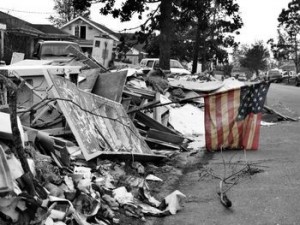
Aftermath of Hurricane Katrina
With climate change comes more intense floods and droughts in designated areas as well as uncertainties regarding the frequency, severity, and location of future hurricanes. But to say that these uncertainties (or contradictions) shouldn’t provoke precautionary measures or major adaptations is like dismissing the devastating impacts of Hurricane Katrina altogether. The fact of the matter is nearly two thousand people lost their lives due to the harshness of this storm and the United States’ inadequate preparation/response. These natural disasters will certainly persist and intensify as the Earth’s temperature increases causing oceans to warm, expand, and rise. The question is…will we be ready?
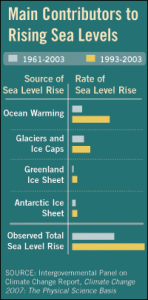
The major contributors to the rising sea-level is the expansion of water as the ocean absorbs heat from the atmosphere and melts water from glaciers and ice caps.
Densely populated, low-lying coastal regions are prone to the highest risk of hurricanes and flooding. But it is not just coastal areas that are threatened. Extreme precipitation events lead to more intense and frequent river flooding causing damage to infrastructure and real estate, problems with water quality and availability, and weakened economies. In several rivers across west and parts of eastern Europe, the return period of what is currently a 100-year flood may in the future decrease to 50 years or less.
In the United States, the National Flood Insurance Program has been criticized for offering policies that encourage people to build homes in flood-prone areas. However, FEMA has recently undertaken efforts to measure the impact of climate change on flood insurance which should result in raising policy premiums and forcing flood lines to be redrawn to include more homes. The question then becomes: how effective will this and similar policies be (that is, if they are even developed) in dissuading development in environmentally unstable areas? History has not lent me much confidence regarding this issue.

Miami skyscrapers and development along the coast. This is essentially the status quo, or model, for beach cities around the world.
And what about the many cities that already exist in dangerous areas? The Organization for Economic Cooperation and Development lists 10 cities face the highest risk from flooding right now due to their geographic placement: Mumbai, Guangzhou, Shanghai, Miami, Ho Chi Minh City, greater New York City, Calcutta, Osaka-Kibe, Alexandria and New Orleans. Additionally, ten percent of the world’s population lives within 10 m of sea level. Areas like Bangladesh are even worst off as nearly 50% of the population live within this echelon. Clearly, these cities need to develop and implement infrastructure for protection. But where will the funding come from? Poor countries often have the most difficult times adjusting to increased environmental threats as they lack the resources to build protection for their cities are unable to mobilize and move in the face of danger.
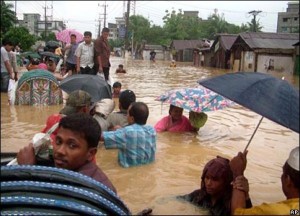
Flood in Bangladesh
If we were completely aware of the dangers of climate change before developing these major cities the answer would be clear—don’t do it! But these are the homes for millions and millions of people; it would be unreasonable and unfeasible to think they can just leave. So will stricter building codes, planning regulations and insurance laws be the answer? Although they must play a larger and more responsible role in the future, my guess is no. The only clear answer must address the heart of the problem. We have to stabilize GHG concentrations in the atmosphere at a level that would prevent dangerous anthropogenic interference with the climate system.
Tags: climate change, Drought, floods, hurricanes, sustainable development
“A Stitch in Time: General Lessons from Specific Cases” details nine general lessons about adaptation to climate change. Number four on this list is “increase awareness and adaptation.” The authors of this article used case studies as proof that there are information “problems” in terms of communicating, advancing, interpreting, and applying the management of climate change. Additionally, the authors later attribute this lack of knowledge as a major reason for lack of will to adapt and mitigate climate change.
So if there is a general lack of education about climate change, what actions should we take to increase knowledge of the importance of adaptation and mitigation? Is reform needed at the national education policy level? If so, at what age level should schools teach climate change? Or, would supplemental educational programs be more effective? Perhaps just solid “green” leadership (governmental or non-governmental) would help.
Laura Wray and Constance Flanagan discuss the impact of youth’s perception of the government’s role in mitigating climate change on youths’ own motivation to “preserve the environment.” Quoting Al Gore, Wray and Flanagan state:
Gore argues that in America, “political will is a renewable resource.” Perhaps one way to renew this resource is to start focusing more on young people and their understanding of, as well as contribution to, environmental problems.
One great example of a project that greatly improved public knowledge of climate change is the documentary “An Inconveient Truth” by Al Gore. In Austrailia alone, some speculate that the documentary was enough to convience official cabinet members to change their skeptical stance on climate change (in addition to convincing large portions of the general public). Surprisingly, Andrew Revkin of the New York Timesblog “Dot Earth” postulates that it is possible that a new video game, “Sim City Societas,” could exceed “An Inconvenient Truth” in widespread educational impact. The game conveyes the short and long-term impacts of climate change, as well as forces players to make decisions with regards to energy sources.
Through multimedia such as documentaries and video games, successful models have helped improve public knowledge and education about adaptation to and mitigation of climate change. Perhaps promoting the advancement of these types of materials would have a larger impact than tackling the beast that is public school curriculum reform. Whatever the forum, more needs to be done.
Tags: An Inconveient Truth, climate change education, student-citizens
One of the largest issues posed by climate changes is the decreasing availability of fresh water. With the population expected to rise to 9 million by the mid-21st century, the attention of the world will soon shift from concerns over fossil fuel resources to water sources. Water wars are nothing new, but with the increasing stresses of changing precipitation patterns, competition for water resources will be nothing short of fierce.
Climate-driven water shortages

Monsoonal rainfall occurs when clouds are too heavy to rise over mountain ranges. They may hang over and area for weeks before they have dumped enough water to blow over the mountains.
The warming atmosphere is expected to shift many of the conditions controlling patterns of precipitation, causing changes in weather patterns worldwide. Increasing evaporation due to higher temperatures will feed a more vigorous water cycle, introducing more frequent, violent monsoon events in some areas of the world. Therefore, monsoons, huge rainstorms caused by warm weather systems getting “stuck” on the ocean side of a mountain range, are expected to increase in intensity in southwest Asia. An increased volume of rainfall sounds like a good thing, but monsoonal rains fall too hard and too fast for the ground to absorb the liquid. Instead, high-speed rainfall will stir up huge volumes of mud and sediment and create big, muddy, dirty puddles, unfit for drinking and a breeding ground for infectious diseases.
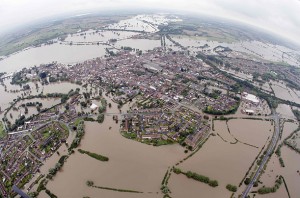
Floods bring gallons and gallons of water, but most is unfit for drinking.
In other areas like the southwestern United States, the frequency of severe droughts is expected to increase sharply in the next decades. The Ogallala Aquifer, which spans eight southwestern states, supplies 30% of the groundwater used for irrigation in the Great Plains region, the “bread basket” of the country. Overuse of the aquifer has already led to severe depletion, and an increasingly arid climate will prevent the aquifer from recharging fast enough to keep up with human use. This will pose colossal problems for water systems that are already stretched thin, causing a swift drop in agricultural productivity and severe water shortages in the area of highest population increase in the country.
Like the Ogallala in the Great Plains, the Colorado River is the blood vessel of the North American west. Extending from central Wyoming all the way down to Mexico, this enormous river is the primary source of water for the driest area of the continent, supplying water to major cities like Los Angeles, Phoenix, and San Diego, supporting over 27 million people. Water distribution has been closely controlled since the 1800s, but each year, as the population in the west grows, there is less and less water to meet the residential and agricultural needs. Water rights between states and with Mexico are already hotly contested, and a more arid climate will continue to exacerbate the problem.
Sustainable use of the Colorado River
Adaptation
It is absolutely essential that we develop ways to conserve water. Fortunately, there are a few very simple ways to begin limiting our water intake. The open, concrete aquaducts that redirect the Colorado River across the southwest United States allows for nearly 90% of that water, the primary source of irrigation for the southwest and Mexico, to evaporate. Simply instaling covers over the concrete riverbeds would limit such an unnecessary loss.
On a broader scale, however, the solution is not so simple. WIth glaciers melting in the Alps and changing climate threating the rainfall we have come to expect, it will take some tremendous creativity to keep water available for a rapidly-growing population.
Tags: climate change, monsoons, Water shortage, water usage
As global warming is getting more severe, it poses huge stresses over both human beings and the nature. Even though the impacts of global warming are rising and some of them might have been underestimated, it is still a good thing that people have recognized the adverse effects of global warming, and have been trying to reverse the trend.
The most important thing to do is to correctly and comprehensively identify the impacts before taking real actions. There are without doubt some positive outcomes such as the rising temperature might give people who are living in subpolar areas a better living environment, but the negative impacts definitely outweigh the positive ones. Human beings have been affected the most by climate change in various ways. So here I want to examine the impacts climate change has on human beings.
Food supply
Agriculture is very sensitive and vulnerable to climate change. Some countries might benefit and increase productivity from a very small increase in temperature, but that is not the case in the long run. And it is also detrimental for many other countries, especially the ones that have already been suffering from shortage of food. Factors that influence agriculture productivity include, but not limited to, change in precipitation patterns, rising carbon dioxide amount in the atmosphere, extremely weather conditions such as droughts and floods. All these factors will only have a negative impact on agriculture and probably reduce the productivity substantially.
Moreover, with increasing percentage of carbon dioxide in the sea and lakes and worsening water pollution, it is very likely that aquatic population will get greatly reduced.
Human’s health condition
With global warming and atmospheric carbon dioxide concentration, insects and rodents may carry and spread diseases that it can be fatal if humans got infected.
With very unstable temperature, a large number of people, mostly elder people, cannot make it through extremely cold or hot weather. A great example of this would be the heat wave happened in summer 2003 in Europe. It was one of the hottest summer in Europe’s history and it was estimated more 35,000 people died because of the heat. Global warming also causes other different kinds of extreme weathers such as storms and droughts by which human lives are greated threatened.
With high carbon dioxide concentration and different kinds of particles caused by it in the air, it is very likely to make people have lung or heart problems. A study showed that around 700 to 800 deaths in recent years were caused by human-generated carbon dioxide emissions.
Rising sea level

Even with a very small increase in sea level, it could bring a huge impact. Higher temperature would raise sea level by “expanding ocean water, melting mountain glaciers and small ice caps, and causing portions of Greenland and the Antarctic ice sheets to melt.” It was estimated by IPCC that the sea level would rise between 0.6 and 2 feet in the next century. Rising sea level poses a huge threat on human’s daily life in various ways. Firstly, coastal areas are being greatly threatened by the sea level. Coastal areas tend to be economically prosperous and popular tourism sites. There are over 600 million people living in those high-risk places. If the rising sea level began to affect those areas, not only the economy would be hurt, but also people’s lives would be threatened. Secondly, with sea water flows into both surface and underground water, it will make the level of underground water rise and the surface water salty. A large aspect of people’s everyday living depends on fresh water, and this will definitely reduce the fresh water supply. With growing economy and population, some countries cannot find enough fresh water supply already, and it will only get worse if sea level kept rising.
Right now, global warming is already inevitable, the only thing we can do is to alleviate the impacts it has on not only human beings, but also the nature to maintain a livable environment.
Tags: Climate change impacts, Global warming, Sea level rise

Kilimanjaro Snow Melt
A week ago, on Monday Sept. 21, the world premier of “The age of stupid,” a new documentary on environmental behavior (or lack thereof) took place in New York. Troubled by the prospects environmental scientists are presenting, frustrated with the hesitant position of policymakers, and convinced that individual people are not taking the right steps to lead more sustainable lifestyles, I made it my mission to go out and talk to as many people as I could about the dangerous situation we are currently facing. First stop was a skype date with my parents who live in Montevideo, Uruguay, largely oblivious to the goings-on of climate change policy, and climate change itself. For them, like for most ordinary people, climate change is just not high on their priority list. After listening to about twenty minutes of my ramblings, my mother declared, with sincere hope in her voice, that “[my] generation would fix it.”
I stared at her image on my computer in disbelief, not really knowing how to explain to her that there just isn’t enough time. (I desperately tried to avoid the “mom, you just don’t get it” teenager tone and opt for a more pragmatic approach.) What this conversation made me realize is that, in truth, the collection of observed facts, statistic predictions and climate simulation models is rather overwhelming and mostly inaccessible to people who lack the scientific training necessary to interpret it. However, there is some basic information that everyone should be exposed to, mainly because within a not-so-long time span, their strong effects will be sorely felt. Here are a few things M. E. Mann and L. R. Kump suggest we should keep in mind:

Kids in Paris during the 2003 heat wave
1. Temperatures measured on Earth’s ground, atmosphere and oceans show that the planet is already warmer than it was before industrialization (by almost 1o C) and that warming rates have doubled over the last 25 years.
2. The observed warming can be explained as the effect of human influence, mostly due emissions of CO2 and other greenhouse gases, and not by the pattern of variations in the natural factors affecting climate, such as solar radiation or Earth’s orbit. (Human-produced CO2 molecules have a particular fingerprint which differentiates it from other CO2 molecules.)
3. Initial changes to Earth’s ecosystems set off feedback loops, which sometimes amplify warming tendencies, making the effects of human interference with climate more long-term and more difficult to evaluate.
4. The consequences of climate change are already being experienced: the 2003 European heat wave, the melting of the Kilimanjaro snows, and the drought in western North America are all related to global warming.
5. To some extent, climate change is irreversible and sea level rises as well as extreme weather conditions will be experienced in the next century. However, if human-generated greenhouse gas emissions peak by the year 2020, and are significantly reduced over the following few decades, it will be possible to stabilize global temperatures at a level compatible with human life and development.
The difference between my position on environmental issues and my mother’s is that, beyond knowledge on the scientific aspects of climate change, I am aware that the political decisions that determine whether we face this problem head on, or cross our arms and whine about lost innocence (and income), are being made now. Copenhagen is only a few months away and my worry is that, not only are we disregarding the science, we are completely disengaged with the times.
Tags: climate change, climate change education, COP15 Resources, Dickinson College, human-induced
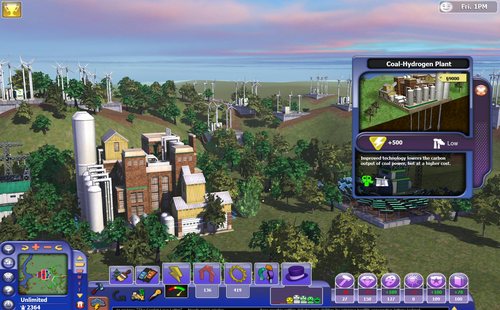
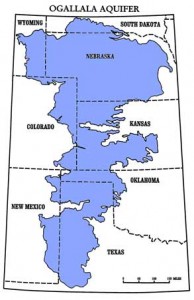
Your Comments